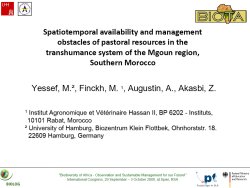|
|
|
 |
|
|
Presentation
< back to presentation overview
| Details of the presentation |
| Presentation |
Oral presentation |
| Title |
Spatiotemporal availability and management obstacles of pastoral ressources in the transhumance system of the Mgoun region, Southern Morocco.
|
| PDF Download |
 Download PDF (Filesize 6 MB)
Download PDF (Filesize 6 MB)

|
| Short title |
Spatiotemporal availabiliy of pastoral ressources in Southern Morocco
|
| Author(s) |
Yessef, M.(1); Finckh, M.(2); Augustin, A.(2); Akasbi, Z.(2)
|
| Presenting author |
Yessef, M.
|
| Institution(s) |
(1)Institut Agronomique et Vétérinaire Hassan II, BP 6202 - Instituts, 10101 Rabat, Morocco; (2)University of Hamburg, Biozentrum Klein Flottbek, Ohnhorststr. 18. 22609 Hamburg
|
| Keywords |
grazing, rangeland management, permanent monitoring, GPS tracking
|
| Abstract |
BIOTA-Maroc monitors the vegetation along an altitudinal transect through the Mgoun region in the Central High Atlas. This arid environment is strongly affected by increasing land use pressure.
Mobile and sedentary grazing systems, mainly with sheep and goat, and firewood extraction are the land uses with highest impact on the vegetation. BIOTA-Maroc investigates the spatiotemporal availability of biomass and forage and tries to identify, together with local stakeholders and Moroccan counterparts, actual limitations and possible solutions for sustainable pastoral management systems.
This investigation follows multiple approaches. To analyse the temporal biomass availability over the year, we conduct weekly phenological measurements on selected forage plants. Furthermore, functions that describe the relation between size and foragable biomass have been established for selected species. This data will be used to estimate the biomass development on permanent monitoring sites, set up in pairs of grazed plots and excloded reference sites along the transect. The plots have been annually monitored since 2001 and thus provide excellent information about vegetation processes driven by pastoral land use.
In order to better understand the local grazing systems, goats of sedentary as well as transhumant herds were equipped with GPS devices. The integrated information about daily grazing distances, altitudinal movements and seasonal forage availability in different ecosystems helps us to model spatial aspects of pastoral systems and thus to elaborate flexible spatiotemporal management solutions.
Territorial aspects of rangeland management, analyzed in close cooperation with GLOWA-IMPETUS, include the spatial incongruity of traditional and modern institutions for rangeland management. Mutual lack of acceptance between traditional and modern stakeholders constitute a key obstacle for feasible management concepts.
|
| Congress Topic |
Land use, impact and value
|
| Topic No. |
3.8 |
| Notes |
---
|
| Ref. No. |
637 |
|
|
|
